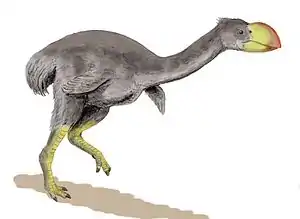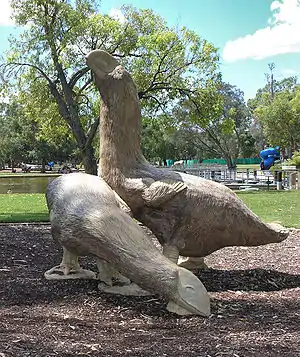Donnervögel
Die Donnervögel (Dromornithidae) waren große, flugunfähige Vögel aus Australien und Tasmanien. Sie sind auch unter dem Namen Riesenemus oder in Australien als Mihirungs bekannt und gehören zu den Gänsevögeln (Anseriformes). Die ältesten Funde sind ca. 20 Millionen Jahre alt.
| Donnervögel | ||||||||||||
|---|---|---|---|---|---|---|---|---|---|---|---|---|

Stirton-Donnervogel (Dromornis stirtoni) in einer Lebendrekonstruktion | ||||||||||||
| Zeitliches Auftreten | ||||||||||||
| Oligozän bis Pleistozän | ||||||||||||
| 20 Mio. Jahre bis 11.000 Jahre | ||||||||||||
| Fundorte | ||||||||||||
| Systematik | ||||||||||||
| ||||||||||||
| Wissenschaftlicher Name | ||||||||||||
| Dromornithidae | ||||||||||||
| Vigors, 1825 |
Dromornis australis und der Stirton-Donnervogel (Dromornis stirtoni) wurden über eine halbe Tonne schwer und 3 Meter hoch. Genyornis newtoni lebte noch im Pleistozän und war den Aborigines bekannt. Knochenfunde in menschlichen Siedlungen zeigen, dass er gejagt wurde. Er starb vor ca. 11.000 Jahren aus. Sein Aussterben ist auf die Klimaveränderungen, Buschbrände und möglicherweise die Jagd zurückzuführen.
Systematik
Äußere Systematik

Die systematische Stellung der Donnervögel wurde unterschiedlich ausgelegt wie nachstehende Kladogramme wiedergeben.
- nach Murray, 2003
- [1]
| |||||||||||||||||||||||||||||||
- nach Agnolin, 2007
- [2]
| |||||||||||||||||||||||||||||||
Innere Systematik
Es sind fünf Gattungen mit acht Arten beschrieben:
- Barawertornis
- Barawertornis tedfordi Rich, 1979
- Bullockornis
- Bullockornis planei Rich, 1979
- Dromornis
- Dromornis australis Owen, 1872
- Dromornis murrayi Worthy, Handley, Archer & Hand, 2016[3]
- Dromornis stirtoni Rich, 1979
- Genyornis
- Genyornis newtoni Stirling & Zietz, 1896
- Ilbandornis
- Ilbandornis lawsoni Rich, 1979
- Ilbandornis woodburnei Rich, 1979
Literatur
- Alan Feduccia: The Origin and Evolution of the Birds. 2. Aufl., Yale University Press, New Haven/ London 1999, ISBN 0-300-07861-7.
- Peter F. Murray: Magnificent Mihirungs: The Colossal Flightless Birds of the Australian Dreamtime. Indiana University Press, 2003, ISBN 0-253-34282-1.
Weblinks
- 'Thunder Birds' - The Family Dromornithidae in Australian Museum online
- Stephen Wroe: The Bird From Hell? Nature Australia, Volume 26, no 7:56 - 63 online
- Morsche Knochen plagten den Donnervogel
Einzelnachweise
- Peter F. Murray (2003): S. 169.
- Federico L. Agnolin: Brontornis burmeisteri Moreno & Mercerat, un Anseriformes (Aves) gigante del Mioceno Medio de Patagonia, Argentina. Revista del Museo Argentino de Ciencias Naturales Nueva Serie 9, 2007, S. 15–25.
- Trevor H. Worthy, Warren D. Handley, Michael Archer and Suzanne J. Hand. 2016. The Extinct Flightless Mihirungs (Aves, Dromornithidae): Cranial Anatomy, A New Species, and Assessment of Oligo-Miocene Lineage Diversity. Journal of Vertebrate Paleontology. DOI: 10.1080/02724634.2015.1031345